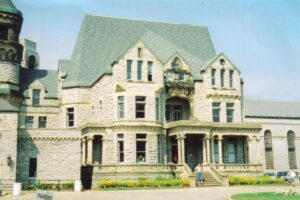
The Ohio State Reformatory.
If you saw the excellent film, The Shawshank Redemption, or the political thriller, Air Force One, then you’ve had a glimpse inside the Ohio State Reformatory, located in Mansfield, OH. But you likely didn’t know that this former prison is considered to be one of the most haunted places in America.
A GRIM HISTORY
Construction on the Ohio State Reformatory began in 1896, the year that the first 150 offenders were incarcerated there. Not until 1910 was construction deemed complete, the delays due to lack of funding and other issues.
Still, the prisoners kept on coming, and for decades they endured under the most horrid conditions. Over 200 people died at the prison until its closure in 1990 via federal court order resulting from a class action lawsuit by the prisoners, which cited inhumane conditions and overcrowding. The deaths included two guards who were killed during an aborted escape attempt, and the prison’s farm boss, his wife and daughter, who were kidnapped and executed by disgruntled parolees.

The prison displayed romanesque architecture.
And, quite tragically, a warden and his wife, the former having served at his post for nearly twenty-five years.
THE END—BUT A NEW BEGINNING
Arthur Glattke, a political appointee, became warden in 1935 and arguably was the best thing that ever happened to the prison. The reforms he implemented earned him the respect of both his peers and the inmates.
In 1950 his wife, Helen Glattke, accidentally shot herself while reaching into a jewelry box. She died of pneumonia a few days later. Arthur Glattke, doubtless mourning his lost love, suffered a fatal heart attack in 1959.

This film was shot at the Ohio State Reformatory.
Things went downhill after that, and as mentioned, the Ohio State Reformatory shut down at the end of 1990, its inmates moved to the Mansfield Correctional Institution. Undoubtedly, part of what caused the shutdown had to do with those 200+ folks who perished there, either by virulent disease caused by the appalling conditions, or by rampant violence, or by tragic accident. Over the decades the tormented spirits of these people have been reported walking throughout the prison, as well as the grounds. How unnerving must that have been for the staff and the prisoners?
After demolition began on portions of the prison, an organization called the Mansfield Reformatory Preservation Society was formed in 1995. They turned what was left of the prison into a museum, and they conducted tours—yes, including ghost tours—to raise money for what they hope will be a complete restoration of the old reformatory.
You’ll find a ton of information on the Ohio State Reformatory website. Check it out.
